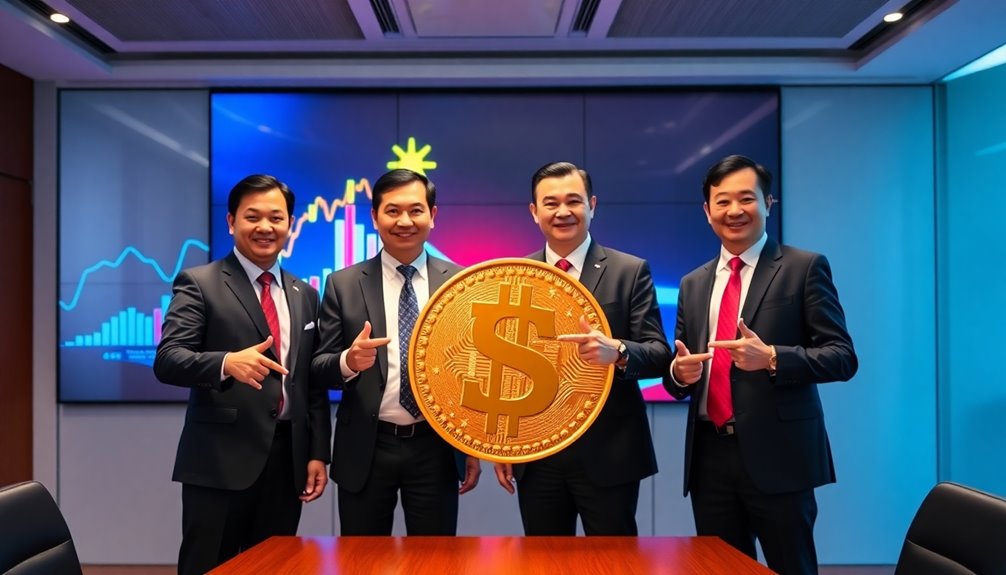The Philippine Banking Quartet, which includes Union Bank, RCBC, Cantilan Bank, and Rural Bank of Guinobatan, just launched a peso-backed digital currency initiative. This project aims to transform financial transactions, focusing on real-time payments and enhancing cross-border remittances for Filipinos globally. By utilizing advanced blockchain technology, like Hyperledger Fabric, they plan to ensure secure, low-cost transactions. The PHPX stablecoin will support fast payments for services like tuition. This initiative is set to address high remittance fees and improve financial inclusion. You'll discover more about its potential impact and the technology behind it soon.
Key Takeaways
- A consortium of Union Bank, RCBC, Cantilan Bank, and Rural Bank of Guinobatan is launching the PHPX stablecoin in 2025.
- The initiative aims to facilitate real-time remittances for overseas Filipino workers, targeting $40 billion in annual remittances.
- PHPX stablecoin operates on a permissioned Hedera DLT network, ensuring regulatory compliance and security.
- The project promises significantly lower transaction fees and quicker transfers by eliminating intermediaries.
- Regulatory oversight by BSP and SEC is crucial, with new regulations for crypto service providers expected before the launch.
Participating Banks Overview

The Peso-Backed Digital Currency Initiative features a diverse range of banks, each playing a crucial role in the project's development.
Union Bank of the Philippines stands out as a top digital institution with its blockchain unit, actively managing a token-based automated clearing house for rural banks. Notably, Union Bank is the only bank with a publicly-facing blockchain unit in the country.
Rizal Commercial Banking Corporation (RCBC), a major player in the sector, focuses on digital finance, participating in the PHPX stablecoin project.
Smaller banks like Cantilan Bank and Rural Bank of Guinobatan contribute to this initiative by enhancing cross-border payments and promoting financial inclusion. They're not just participants; they're integral to the governance and compliance of the PHPX project, ensuring it meets regulatory standards and benefits the community.
Goals of the Initiative

Participating banks are united by a common vision in the Peso-Backed Digital Currency Initiative. They aim to enhance cross-border payments, targeting the $40 billion in annual remittances from overseas Filipino workers. By enabling real-time payment solutions, you'll be able to pay for services like school tuition directly, reducing costs and improving efficiency. This initiative also promotes financial inclusion, offering a regulated, risk-free digital currency backed by the Bangko Sentral ng Pilipinas. CBDCs aim to modernize the financial system and you can expect faster transactions, unconstrained by traditional banking hours. Additionally, the initiative addresses remittance challenges, bypassing high fees and facilitating quicker transfers, making daily expenses more manageable.
Technology and Infrastructure

As the Peso-Backed Digital Currency Initiative unfolds, leveraging advanced technology and robust infrastructure is key to its success.
You'll see the use of Hyperledger Fabric and Hedera DLT to enhance programmability and facilitate cross-border payments. This decentralized ledger technology (DLT) not only boosts security but also ensures interoperability with other blockchain assets. The selection of Hyperledger Fabric reflects its advantages in supporting on-chain settlement for blockchain assets. Additionally, utilizing cryptographic hash functions enhances the integrity of transactions recorded on the blockchain.
You'll notice a combination of virtual and physical components designed for secure connections among participants, while global compliance is prioritized for international transactions.
Scalability remains crucial, allowing the system to handle increasing transaction volumes.
Details of the Stablecoin

While focusing on enhancing financial inclusion in the Philippines, the Peso-Backed Digital Currency Initiative introduces PHPX, a stablecoin designed to facilitate seamless transactions.
This initiative involves a collaboration of UnionBank, Rizal Commercial Banking, Cantilan Bank, and Rural Bank of Guinobatan, with Singapore-based Just Finance driving the project. The participating banks will play a crucial role in shaping the stablecoin's governance.
PHPX aims to support various use cases, including real-time remittances for overseas Filipino workers and direct tuition payments from abroad. Additionally, the stablecoin is expected to launch between May and July 2025, marking a significant milestone in its development.
Operating on a permissioned Hedera DLT network, PHPX will comply with regulatory requirements and ensure security through segregated trust accounts, making it a reliable option for users seeking efficient financial solutions.
Cross-Border Payment Capabilities

The Peso-Backed Digital Currency Initiative revolutionizes cross-border payments by enabling real-time remittances that are both efficient and cost-effective. You'll benefit from significantly lower transaction fees compared to traditional banking systems, thanks to the use of blockchain and decentralized ledger technology. This eliminates intermediaries, reducing settlement risks and costs while facilitating direct payments, like school tuition, without hassles. Moreover, this initiative aligns with the projected value of payments via CBDCs to reach $213bn annually by 2030, indicating a robust opportunity for growth in digital currency adoption.
Regulatory Considerations and Timeline

Navigating the regulatory landscape is crucial for the successful implementation of the Peso-Backed Digital Currency Initiative.
The Bangko Sentral ng Pilipinas (BSP) and the Securities and Exchange Commission (SEC) are key players in overseeing this project.
Crypto exchanges and service providers must register with both agencies while adhering to Anti-Money Laundering (AML) and Counter-Terrorist Financing (CTF) laws. Additionally, the SEC's proposed regulations for Crypto-Assets Service Providers emphasize the need for compliance and regular audits.
The SEC is currently drafting rules, with a public feedback period running until January 18, 2025.
Expect the launch of the PHPX stablecoin between May and July 2025.
Compliance is non-negotiable, and failure to meet requirements could lead to serious legal consequences.
Staying updated on regulatory developments ensures your operations align with evolving laws.
Frequently Asked Questions
How Will This Initiative Impact Everyday Banking for Filipinos?
This initiative will transform everyday banking for you by making transactions faster and more accessible.
You'll benefit from real-time clearing, allowing you to send and receive payments anytime, even during off-hours.
It'll reduce costs by eliminating intermediaries, making financial services more affordable.
With better access to digital currencies, you'll find it easier to manage your finances, especially if you live in rural areas or rely on remittances.
What Security Measures Are in Place for PHPX Transactions?
For PHPX transactions, a range of security measures ensures your safety. Valid signatures are mandatory for every transaction, verifying each step across the network.
Your wallet's security is enhanced through strong passwords and multi-factor authentication. The system employs regular updates to protect against vulnerabilities and uses encryption for private key storage.
Additionally, anti-fraud and AML monitoring systems actively screen transactions, so you can transact with confidence.
Can PHPX Be Used for Online Shopping?
Yes, you can use PHPX for online shopping.
It's designed to facilitate various transactions, including retail and point-of-sale purchases.
With its integration into digital wallets, you can easily pay for bills or shop online without worrying about cryptocurrency volatility.
The stablecoin's security features ensure your transactions remain safe and stable, making it a practical choice for everyday purchases.
Enjoy the convenience and lower fees that PHPX offers while shopping online!
Will There Be Fees Associated With Using PHPX?
You mightn't face explicit fees when using PHPX, as the initiative aims to reduce or eliminate traditional cross-border transaction costs.
While no specific user fees are mentioned, it's possible that some operational or compliance costs could be passed on indirectly.
The focus is on streamlining transactions to make them cheaper and faster compared to traditional methods, so you could benefit from lower expenses overall when using this digital currency.
How Will Customer Support Be Handled for PHPX Users?
Customer support for PHPX users will be streamlined and accessible.
You'll have multiple channels to get help, including online chat, phone support, and FAQs on the platform.
The participating banks will ensure that your inquiries are addressed promptly, whether it's about transactions, fees, or technical issues.
They'll also provide educational resources to help you navigate the system, making your experience smooth and user-friendly as you adopt this new digital currency.
Conclusion
In conclusion, this Philippine banking quartet's peso-backed digital currency initiative marks a significant step toward modernizing financial transactions. By leveraging advanced technology and focusing on regulatory compliance, they're poised to enhance cross-border payment capabilities and promote financial inclusion. As these banks work together, you can expect a smoother, more efficient banking experience that caters to the needs of the digital age. Keep an eye on this initiative; it could reshape how you interact with money in the future.









